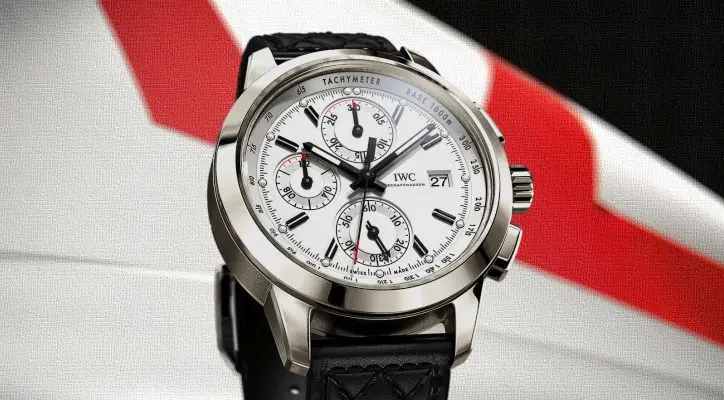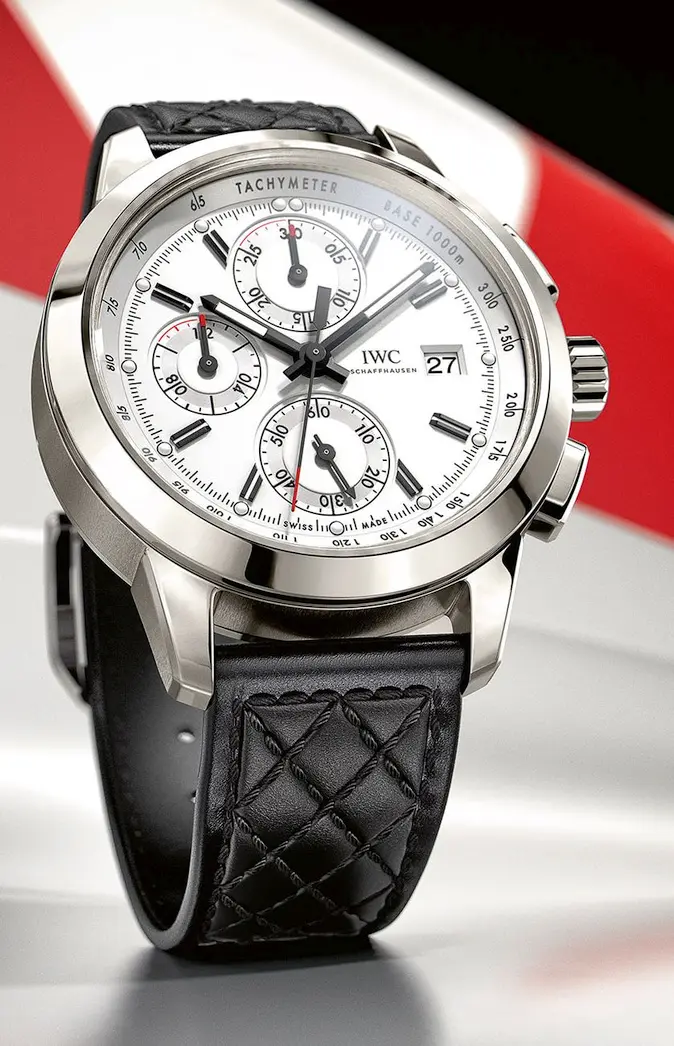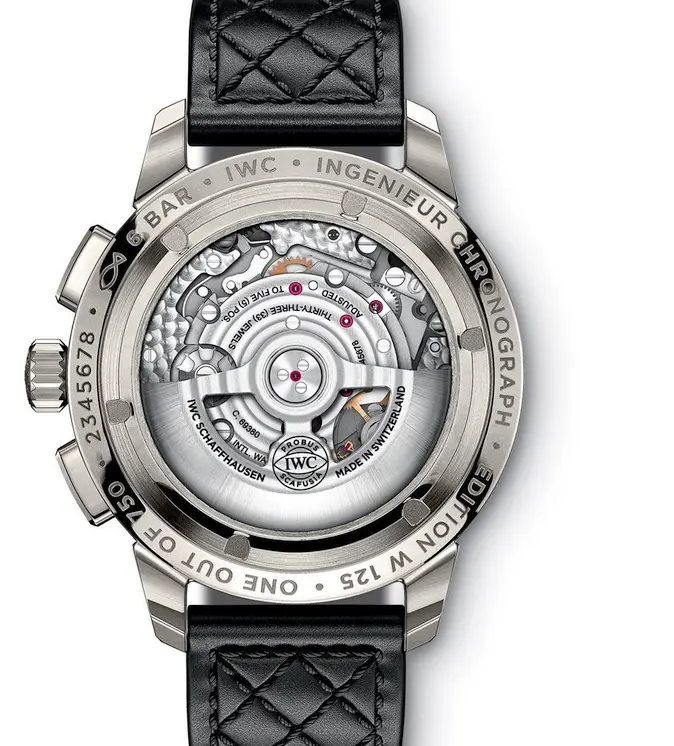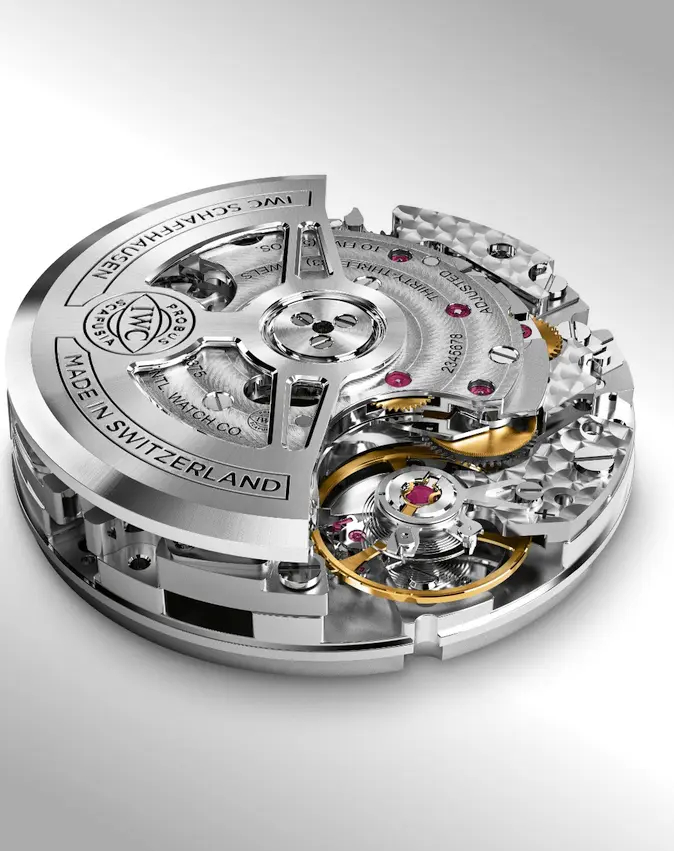
The limited-edition 2016 IWC Ingenieur Chronograph “W 125” IW380701 comes in a nice -if somewhat bulky- titanium case. A true piece of luxury, the watch features an appealing combination of mirror-polished front surfaces that are nicely accented by deliberately roughly brushed sides.
Set to go on sale in just three or four months (they mention the “autumn” in the press release), the new member of the legendary Ingenieur family will sell at a competitive -I mean, um, all things considered- price of just over $7000.
Overall Impression
A chronograph like this is just bound to be a bestseller. While not offering anything groundbreaking in terms of industrial design, it compiles everything we love about the Ingenieur family -including an elegantly-ruggedized look, high-contrast dial layout, and a good mechanism that keeps everything going- into one competitively priced versatile package that looks nice with any sort -from formal to casual- of attire.
Although at least within this price range, I would probably prefer something higher-end than the mechanism that was chosen for this model, I should say that even this in-house job makes a nice impression with its technical specs. And it allows the brand to keep the price down, too, without hurting their margins too much.
I would probably like it even more if the piece was just two or three millimeters thinner, but it makes a strong impression even as it is.

Case & Strap
I am glad that the “supersizing race” in the niche of luxury timekeepers has finally stopped and we start to see a flow of relatively compact wristwatches coming to boutiques and multi-brand stores near us.
This particular Ingenieur Chronograph “W 125” almost nails it when it comes to the piece’s diameter-to-thickness ratio measuring approximately 42 millimeters in diameter that makes it suitable for most wrists out there, yet is just 15 millimeters thick: good news to persons planning to wear these beauties with formal attire.
Of course, the long and massive horns may make this watch a tad too “solid” for a person who is more used to dressier time-measuring devices, however when we talk about the Ingenieur line, the overall massiveness kinda’ sorta’ comes with the territory, doesn’t it?
The design allowed the Swiss engineers to also make the case more ergonomic with its huge, easy-to-grip winding/setting crown and huge chronograph push-pieces that make operating the function easy and comfortable, too.
Featuring alternately brushed and polished surfaces, the stainless steel case is also equipped with a screw-in case back that features a sapphire crystal giving a superb view of the in-house IWC caliber 69370 that powers this device.
Traditionally for the brand, the case back cover seems to be machined from a piece of solid steel and features a complex shape. The effect is somewhat spoiled by all the technical inscriptions engraved on the outer rim of the back, but that, too, is something to be expected.
The front crystal is, too, cut from a piece of synthetic sapphire glass and features a convex profile that -together with coatings of anti-reflective treatment on its inner and outer surfaces- makes reading the dial even easier. It will probably collect more scratches on the aforementioned coatings due to its profile, but you should simply have to be more careful with a gadget that costs like an entry-level motorcycle, that’s all.
The strap is, of course, as premium as is theoretically possible when you are buying a $7k watch: the black calfskin leather strap features expensive-looking (probably done by hand) black stitching and comes with a titanium pin buckle that, while not as convenient as a deployment clasp, makes a nice impression with its old-school look and feel.

Dial
The silver-plated dial with its usual three-dimensional look offers an unusual chronograph layout with the 12-hour sub-dial placed at 9 hours and the 30-minute display located at 12 o’clock.
Although I have heard numerous complaints from “purists” regarding the way the counters were positioned (mostly about how “untrue” and “non-historic” it is), I can see a certain logic behind the decision. Nowadays, when a mechanical chronograph is more of a toy than a tool (as is the inevitable tachymeter scale on the inner bezel flange,) people mostly use the instrument to measure relatively short time intervals that rarely exceed more than five or ten minutes and rarely at that (something tells me that using the Ingenieur as an egg timer could be considered a waste of money even by die-hard fans of the Pomodoro productivity technique) and with this sort of use you would want the minutes to display to take the most visible place on the dial with the hours indicator being moved to a more, well, secondary position.
The legibility is great for a classic chronograph. The blacked-out hands and hour markers with portions of white Superluminova on them look high-contrast over the silver background, ditto the black chronograph hands, as well as the small second’s indicator at six o’clock.
The Swiss brand even decided to further visually differentiate the chronograph indicators from the rest of the pack by using red tips on the pointers themselves, as well as red sectors on the tiny chapter rings. The date aperture is predictably tiny but is still large enough even for double-digit numerals to be easily readable even by persons with not that stellar eyesight.
Oh, and the overall “three-dimensional” look and feel of the dial plate with its applied indices and the secondary luminous dots over them make the dial look even classier. Well, that’s something that must be expected in this price range, I suppose.
Perhaps, the only thing that disappoints me here (well, just a tiny bit) is the lack of a “day of the week” function that could have made the watch even more useful for a person constantly preoccupied with their thoughts, but, again, you can’t have everything, right?
Mechanism
Swiss engineers decided to employ the self-winding IWC Caliber 69370 to power this model. This is a version of their relatively new Cal. 69000 base movement from 2015. Designed to animate their entry-level collections, this simple movement has been gradually replacing the legendary ETA 775x calibers as the brand’s overall push to stop relying on third-party mechanisms and go completely in-house.
Built on 33 jewels and comprising more than 200 components, the 30 mm x 7.9 mm movement features an average (but sort of underwhelming by today’s standards when it comes to premium-priced timekeepers) power reserve of 46 hours.

Priced at more than $7000, the W 125 doesn’t look particularly affordable, but IWC has a dissenting opinion on this matter. I mean, the mechanism’s finish looks like it was deliberately cheapened with its bridges featuring nothing but CNC-machined circular Geneva Stripes and some circular-graining, while the skeletonized oscillating weight not only became more generic in terms of finish but has also lost the signature 18-karat gold “Probus Scafusia” medallion in the process.
Well, their 7750-based mechanisms never looked especially fancy either, so the way the cal. 69370 is finished doesn’t come as that big of a surprise although I am still convinced that IWC acts cheap in this regard. Shame on them.
It’s probably still too early to give any projections regarding the mechanism’s long-term reliability, but, again, the Caliber 69370 is a fairly simple time-measuring machine and I just don’t see how such a huge brand as IWC could’ve screwed it up quality- and design-wise.
Pricing & Availability
As usual, the limited edition will go on sale sometime this upcoming autumn with international availability probably scheduled for late Q3 or even early Q4. With a total number of units limited to just 750 pieces, in the United States, the W125 will cost around $7250 (local taxes, as far as I understand, are not included.)
Frankly, I am a bit surprised that IWC decided to issue the chronograph as a limited edition only: I believe that there would be a strong demand for something like that not only from the brand’s die-hard fans but from the more casual audience as well. Probably, it has something to do with the current state of the world economy and the brand’s desire to put as much premium on the price as possible. Breitling does that for years now and I don’t see why IWC wouldn’t have had luck with this approach as well.
See also: IWC Top Gun Miramar Chronograph IW389002
Photos: IWC
WWR verdict
Originality 4/5
Build quality: 5/5
Usability: 4.5/5
Legibility: 5/5
Value for money: 4.5/5
IWC Ingenieur Chronograph “W 125” in Titanium IW380701 specification
Price: $7250 USD (MSRP)
Winding: Automatic
Movement: IWC in-house caliber 69370 (base IWC caliber 69000), automatic pawl winding, 30 mm x 7.90 mm, Swiss Made
Number of jewels: 33
Movement frequency: 28,800 vph
Power reserve: 46 hours
Movement decoration: Geneva stripes and circular graining, polished screw-heads, open-worked oscillating weight
Functions: Hours, minutes, small seconds, chronograph, date
Case: Titanium, brushed and polished
Shape: Round
Size: 42.00 mm
Case height: 15.00 mm
Dial: Silvered
Hour markers: Black, luminous, applied
Hands: Black, luminous
Water resistance: 60 meters
Strap: Black calfskin leather strap with black stitching; titanium pin buckle
Crystal: Sapphire, convex, antireflective coating on both sides
Back: Sapphire
